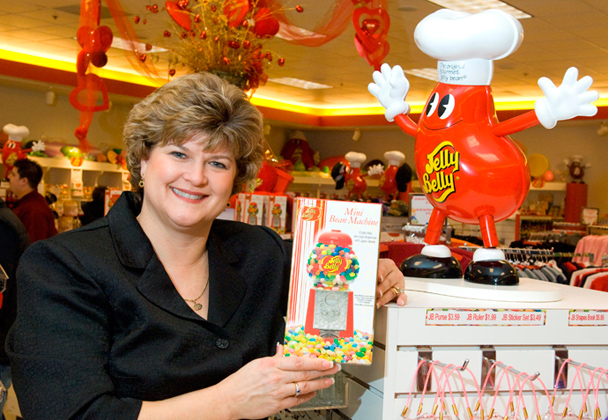One of the biggest names in the jellied candy game is the Jelly Belly Candy Company. Founded in 1869 by the German immigrant brothers Gustav and Albert Goelitz, the family business started making jelly beans in the mid 1960s, and debuted eight gourmet flavors, including Cream Soda, Licorice, and Green Apple, in 1976. The new Jelly Belly beans skyrocketed in popularity. By 2001, the brand had outgrown the Goelitz name, and the one-time small business adopted its current moniker. Lisa Brasher, the founder’s great-great-granddaughter, serves as executive vice chairman at company headquarters in Fairfield, California. She shares an inside look at the making of a Jelly Belly bean, from conception to final polishing, and explains just what it takes for a bean to make the jump from rookie flavor to timeless classic.
Gourmet Live: What’s the most popular flavor of all time?
Lisa Brasher: Very Cherry. It’s pretty much been the most popular flavor since the very beginning, except for a short period when, believe it or not, Buttered Popcorn was the most popular. Very Cherry was one of the original flavors—in addition to Cream Soda, Licorice, Orange, Grape, Lemon, Green Apple, and Root Beer.
GL: How many Jelly Belly flavors currently exist?
LB: Right now we have about 100 flavors, including 50 “official” flavors and 13 “rookies,” which are new flavors that are trying to vie their way into the 50 official flavors. We also have five sour flavors, five Snapple flavors, five “super fruit” flavors that are made with all-natural ingredients and colorings, and five “smoothie blend” flavors. We also have an international department that makes beans for specific countries, including flavors like green tea and cherry blossom. And the latest flavors are our Chocolate Dips, which are a variety of Jelly Belly official flavors covered in rich dark chocolate. There are also a handful of seasonal flavors, such as carrot cake around Easter or hot cider at Christmas.
GL: What are the sources of inspiration for the rookie Jelly Belly flavors?
LB: We get flavor suggestions from all over the place, including letters in the mail and emails from JellyBelly.com. People call us, and we have visitor centers in Wisconsin and California, where 750,000 people tour our facilities every year and have the chance to make flavor suggestions. Our employees, including the flavor scientists, also give ideas.
GL: How does a rookie flavor become a finalist?
LB: The suggestions have to be very specific. You can’t just say, “I want to make Potato Chip flavor.” It’d have to be Barbecue Potato Chips or Salt and Vinegar Potato Chips. And then we develop the flavors that receive repeated suggestions and those that we think will be really recognizable flavors with that “wow” factor. We made the Ginger bean a few years ago, but because you can have raw ginger or roasted ginger, we had to be very precise in terms of the exact flavoring because raw and roasted come out very differently.
GL: What’s the next step in the process once a rookie flavor has been chosen?
LB: Our team of food scientists makes a small batch to see if we’re getting the correct flavor. All beans are basically made with the same base, and then flavorings or colorings are added to distinguish them. After the food scientists have made a flavor a couple of times, many people taste it, including myself, my dad—who’s chairman of the board and has been at the company for 50 years—and also some employees in the marketing, accounting, and sales departments. During the taste tests, we rate the bean on what it looks like—for example, its coloring—and how it tastes.
GL: Has the original base recipe for the beans changed at all over the years?
LB: No. The base of the beans is water, sugar, cornstarch, and corn syrup. The formula is slightly different for our natural beans, because we use evaporated cane juice in place of sugar.
GL: How long does it take to make a single Jelly Belly bean?
LB: It takes a minimum of 7 days and up to 21 days, because during each step we give the flavor time to develop and cure. It takes a day to cook up the hot liquid candy and shape the centers of the jelly beans. Then they rest in a hot oven for a period of time. They rest again after coming out of the bean molds, and yet again after we put the soft candy shell on the outside. Each flavor has its own schedule to be perfectly finished. Wild Blackberry is an example of a flavor that takes three weeks to get perfect.



 Pinterest
Pinterest


